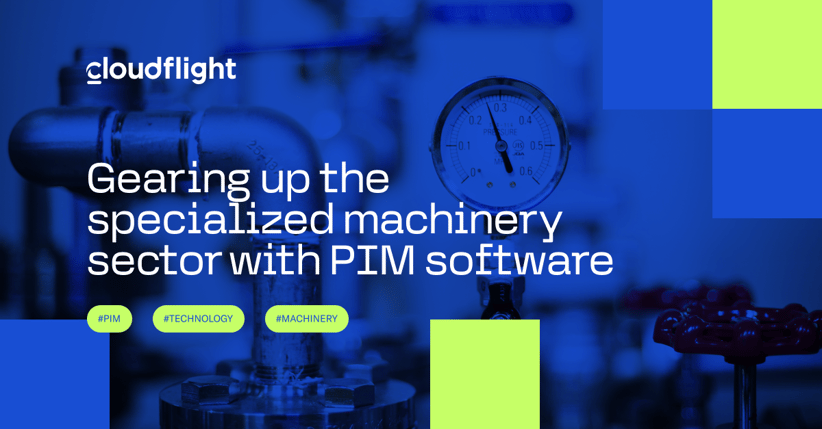In the world of specialized machinery, reliable information is everything. The inherent complexity of products and nearly exclusive focus on B2B sales mean that conveying value has always been a unique challenge. Where other industries can lean on emotions and experiences, the machinery sector needs a no-nonsense approach. Customers don’t care how an expensive machine will make them feel; they want to know precisely how it works and improves their operational efficiency.
However, as the B2B sector continues to embrace eCommerce, it faces a substantial challenge. All the product information once presented in printed documentation that was distributed by sales representatives now must find its way into websites and other digital channels. It also needs to be accessible and maintain its business value in the process.
This calls for specialized solutions, and modern product information management (PIM) systems often turn out to be the missing pieces of the puzzle. Here are three stories about how such implementations helped businesses in the machinery sector refine their online presence.
Document management
It’s only expected that the bigger and more complex a machine is, the more documentation is needed. For every product in this industry, it’s almost a given that there will be numerous general manuals, maintenance and troubleshooting instructions, compliance certificates, and probably some extra paperwork on top of these.
In the “analog” age, this wasn’t too big of an issue. Manufacturers and dealers used to simply print everything out, bind it in a nice faux leather folder, and deliver it to customers along with the product itself. Now, however, things have changed. Customers expect all that information to be easily accessible online long before the product arrives at their facility.
This can pose considerable challenges because generic content management systems (CMS) aren’t built to support those kinds of files. Of course, you can upload PDFs to these systems, but the ability to catalog and tag them will likely be almost non-existent. With a large amount of files at hand, this can easily lead to chaos both at the front and back end of a company website. Luckily, modern PIM systems can play a big part in smoothing things out.
Success story: ECKOLD
 ECKOLD is a pioneering manufacturer of tools and machinery for a variety of industries, including automobile, aircraft, ship and wagon, and even the space industry.
ECKOLD is a pioneering manufacturer of tools and machinery for a variety of industries, including automobile, aircraft, ship and wagon, and even the space industry.
Challenge: a scattered and unintuitive storage
Prior to implementing the media asset management (MAM) system that comes as a part of Pimcore, ECKOLD struggled with effectively organizing various resources. These included training documents, user reports, images, illustrations, and videos.
The company lacked a centralized storage structure with clear paths and access rules for the documents. They were also missing a keywording functionality, which meant that searching through the ever-growing library was a grueling manual process.
This led to delays in creating new materials and accessing necessary assets for sales and marketing purposes. Given ECKOLD's international presence and publishing in multiple languages, a clear and comprehensive view was crucial.
Solution
ECKOLD chose to introduce Pimcore to their infrastructure, which quickly proved to be the right move. The MAM system revolutionized the way the company stores and works with documents related to their products:
- It introduced a centralized repository and a single source of truth for all assets. The repository both supports internal projects, such as the creation of marketing materials, as well as feeds the assets to the website.
- It allowed ECKOLD to establish a role-based system of permissions for weaving and editing documents. This was important because of the company structure as well as matters of compliance with universal regulations.
- It made it possible to assign elaborate keywords, tags, and categories to each file. As a result, searching is now much more intuitive and quicker.
Correspondingly, ECKOLD saw significant improvements in marketing and sales workflows. They’re able to launch products significantly quicker, and the website properly supports customers throughout their entire journey.
Automated creation of brochures and other documents
In the previous section, we took a look at the process of storing and distributing documents, but what if a business needs help at an earlier stage? After all, before these processes can happen, the documents need to be created in the first place.
This can become a significant challenge in itself. If you were to create such documentation manually, it would almost inevitably lead to hours spent looking up the relevant information across numerous sources and then moving it between various tools and formats. It would be a long, tedious process that would also be highly error-prone on top of that.
It doesn’t have to be like this, though. Modern PIM systems often come with some form of a document creation tool that automatically migrates all the relevant data into pre-made templates. Assuming you have the required data already in place in your PIM database, this can cut down the time required to create the documents to mere seconds.
Success story: Triulzi
.png?width=201&height=70&name=logo%20(1).png) Triulzi is a family-owned manufacturer and distributor of specialized industrial machines for washing large glazed surfaces based in Italy. With over 70 years of tradition, they stress the importance of quick and agile responses to client needs as the defining characteristic of the company.
Triulzi is a family-owned manufacturer and distributor of specialized industrial machines for washing large glazed surfaces based in Italy. With over 70 years of tradition, they stress the importance of quick and agile responses to client needs as the defining characteristic of the company.
Challenge: limitations of manual document creation
Prior to the project, the creation of product documentation had been an inefficient manual process. Triulzi’s specialists created the documents one by one in text files and stored them on their PCs without a consistent naming convention.
On top of the obvious problems with time requirements and possibilities for errors that such an approach created, a new one emerged. The company was quickly expanding into international markets, which meant that all the documents created over the years would need to be translated from Italian to English.
Solution
The requirement for translations combined with a generational transition in the company’s management provided a natural push to digitalize the document creation processes. Triulzi decided to take the opportunity and set up an elaborate PIM solution based on Pimcore.
With advanced document creation tools built into the system by default, Pimcore instantly revolutionized the company’s product documentation process. Thanks to a web-to-print module, the relevant product information is pulled directly from the PIM database and automatically inserted into pre-made document templates. The process takes only seconds and, of course, works with product information in Italian, English, and any other language.
Out of all the different types of documents, the creation of operational manuals has seen the biggest improvements. They can be seamlessly illustrated with photos that Triulzi’s staff upload directly into the Pimcore database via a dedicated smartphone app. When a customized design is needed, the module connects directly with Adobe InDesign and eliminates the need to move data manually.
Support for customized B2B eCommerce solutions
Machinery producers and distributors deal almost exclusively with B2B customers. This is hardly a groundbreaking observation to make but an important one nonetheless. B2B eCommerce is very different from its more common B2C sibling. There are different expectations in terms of presentation, the overall user experience, and the buying process, just to name a few.
B2B eCommerce experiences also tend to vary from one another much more than in the case of B2C. For example, if you’ve seen one checkout process in a B2C store, then you’ve pretty much seen them all because they bank on familiarity. It’s a different story for the B2B environment: those processes may introduce extra steps, approvals, roles, and so on, and vary heavily depending on the internal processes of individual companies.
This poses quite a challenge when it comes to building eCommerce infrastructure for such businesses. An off-the-shelf solution usually won’t be able to accommodate the nuances mentioned above, and B2B businesses, such as those in the machinery sector, need to look into more capable and specialized tools. This is another area where modern PIM solutions shine.
Success story: ROEMHELD
ROEMHELD is a German manufacturer and supplier of workholding and clamping systems for a variety of industries. The company is known for producing hydraulic clamping elements, quick die change systems, and related precision components used in metal forming, plastics processing, and automation applications.
Challenge: creating a manageable catalog and sales system for 25,000 products
It would be an understatement to say that ROEMHELD’s product portfolio is extensive. 25,000 different products is a number that one would expect from huge multi-vendor marketplaces and not from a single supplier. Naturally, presenting them in a way that wouldn’t overwhelm website visitors was the first major challenge.
On top of this, it wasn’t as if ROEMHELD could simply dump all the information into a spreadsheet and call it a day. The new website was to serve as the first point of contact for customers and needed to include a functioning cart, meaning that the entire portfolio had to take the shape of fully-fledged products in the sense of eCommerce infrastructure. They needed their individual listings, descriptions, elaborate taxonomies, and space for additional industry-specific assets, such as CAD files.
Finally, all the numbers were multiplied by five because of localized website versions. This posed serious concerns regarding the website’s performance due to the size of the database.
Solution
ROEMHELD built the infrastructure of their new website for Pimcore for two main reasons:
- Features: Pimcore is a MDM ecosystem that includes multiple synergistic solutions, such as PIM, customer relation management (CRM), digital asset management (DAM) systems, and more. This meant that ROEMHELD could consolidate the workflows that had been previously scattered over multiple solutions into a single all-encompassing dashboard.
- Performance: Pimcore is known for its lightweight architecture and the ability to handle large datasets. This guaranteed optimal performance of the website both at the back end as well as the front end.
As a result, ROEMHELD managed to build a website that’s both powerful enough to support the massive database that feeds it and smooth to use. Elaborate category trees and filtering rules ensure that the size of the portfolio isn’t overwhelming to users and that they can find what they’re looking for quickly and intuitively. While it isn’t a store per se, it fulfills the intended function of a bridge between customers and sales representatives, and streamlines the sales process.
PIM systems are the right machinery for digital transformation
The implementation of PIM systems in the specialized machinery sector is more than just mere organizational tools. It becomes the linchpin of agility, efficiency, and global connectivity. As the industry evolves, skillfully implemented solutions can bring it into a future where information isn't just managed; it's harnessed and strategically deployed to build a path to success in the digital age.
The list of benefits, however, goes on, and this article is only meant to give you a taste of the key ones. We've recently released an eBook that goes over more applications and benefits of PIM software in the machinery industry. Make sure to have a look to get a complete picture of what such implementations can accomplish for your business.
Published December 5, 2023











